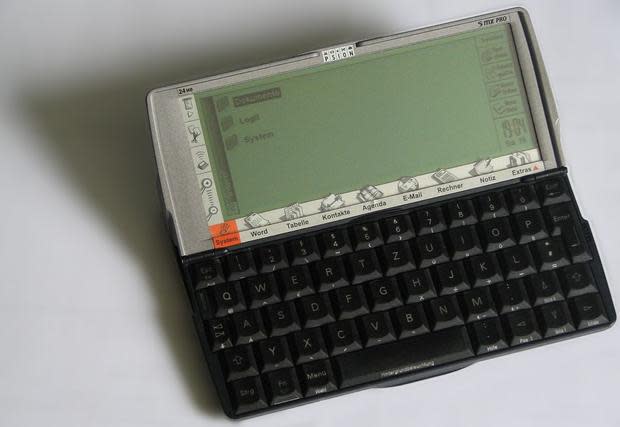Filling the palmtop void

The Psion 5mx boasted a usable keyboard in a pocketable size. Georg Dembowski Schoschi The clamshell has proved as hard to push aside in the PC world as it's been hard to bring back in the mobile world. In the late '90s, operating systems such as Windows CE and Symbian powered palmtops such as the Philips Velo and the Psion Series 5; the latter showed that you could create a usable keyboard in a pocket-size clamshell device.
Like all PDAs, clamshells, or palmtops, were rendered obsolete by smartphones, and those with capacitive touchscreens largely wiped out those with physical keyboards; BlackBerry remains about the only holdout beyond a few messaging phones mostly offered by budget prepaid providers.
But the need for on-the-go productivity gadget hasn't disappeared. Thumb keyboards are handy for typing out a quick e-mail reply, but they can become tiring if used for more than a few minutes. Surely there's a significant enough base of people needing to type out accurate notes at impromptu meetings when there's no laptop or tablet around. And yet, for all the niche products that have sprung forth from the Kickstarter genie, no one's attempted to create a modern palmtop, perhaps one running Android.
The most recent product that represents the virtues of the palmtop is the King Jim "Pomera" line, particularly the DM20 that boasts a folding keyboard and monochrome LCD and can operate on two AA batteries. Lacking any radios such as Wi-Fi or Bluetooth and available for less than $150, it's designed for quick note-taking in meetings and the like. But its keyboard and user interface are designed for the Japanese market, though the interface can be switched to English. Other simple writing products, such as the now-discontinued Neo Writer, have essentially the same profile as a laptop, while the Pandora open-source palmtop is really designed more for gaming than text input.
The problem, of course, is that few people wish to give up the capabilities of their smartphones to enter notes. Not only do we have our smartphones with us, but they offer bona fide advantages when it comes to note-taking. These include access to rich word processors such as DataViz' Documents to Go or Apple's Pages; browsers for researching things we're writing; and cloud services for storage.
Therefore, a modern-day palmtop alternative might be to pair one's smartphone with a folding keyboard, but few good, pocketable ones exist. One promising project, the Jorno, was funded on Kickstarter in fall 2012 but still hasn't shipped. A more recent, cheaper and simpler looking design, the Flyshark, is closing in on its Kickstarter funding goal. Unlike the Jorno, it lacks an integrated smartphone stand so users will have to find some way to prop up their smartphones or tablets.
Compared with the Psion 5mx, arguably the best palmtop of the palmtop's golden age, the FlyShark and Jorno should allow for easier text input. And the displays, apps and connectivity of today's smartphones are light years beyond that product. But combining a Bluetooth keyboard and smartphone entails such hassles as having to pair them and deal with separate batteries and power switches. It's the kind of compensating that products such as Microsoft Surface are trying to do to get what's essentially a slate product to behave like a clamshell.
It's amazing that in this era of retro-videogame projects and throwback platforms with great battery life there hasn't been some grassroots effort to bring back a simple, inexpensive palmtop for on-the-fly creation of notes, longer e-mails and memos. Such a product isn't for everyone, but there must be enough grassroots interest out there to spawn the next Kickstarter niche-tech-product surprise.
Also from CNET:

